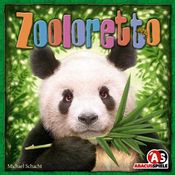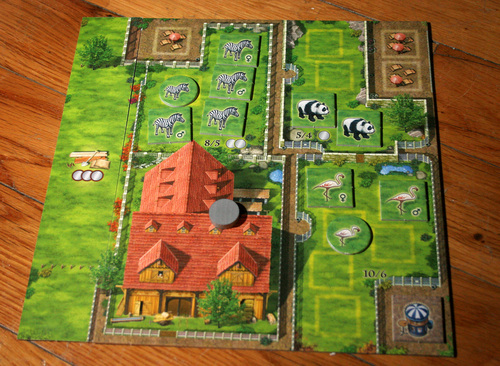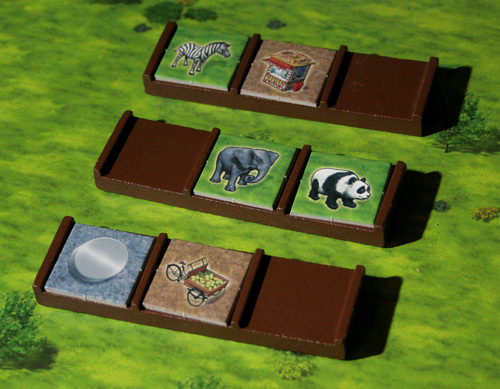Zooloretto: A challenging game hiding behind a cute exterior

So say that you have two 5-year olds and one cookie. You could divide it up for them, but someone’s going to complain that the other one got one chip more and you’ve got a tantrum on your hands. Instead, a clever person might ask one kid to split the cookie knowing that the second kid will get to have first choice of which piece he wants.
Zooloretto is a game that takes those principles, complicates them and turns them into a fun game. Players simultaneously are trying to make groups of animals for their zoo that appeal to them but that aren’t so good for other players that their group of choice gets snapped up before the next turn comes around.
I’ve been meaning to put up a review of Zooloretto for a while, but I’ll be straight forward in that it’s a game that isn’t meant to be explained so much as it is one that is meant to be shown. It’s one of those games where the explainer could sit there and take you through the rules, but until you take your second turn, you won’t quite realize how the rules work together.
In Zooloretto, each player is trying to make the best zoo possible by filling it full of animals. Players earn points for filling the enclosures to their capacity of one type of animal per enclosure; extra animals that can’t be placed will earn the player negative points at the end of the game. So players have to ensure that they don’t get too many extra animals or they may run out of places to put them.
Animals and other items come to the zoo on delivery trucks that have slots for three items. On his turn, a player can choose only one of the following:
- Claim a delivery truck and add its tiles to his zoo
- Add a tile to a truck that is already out there.
- Do a money action that allows zoo expansion or shifting animals in the zoo around.
Let’s take a look at an example so that this makes more sense. Below is your zoo during one point of a game in progress.

Mike Hulsebus | Contributor
As you can see, your zebra pen is full (thanks in part to the baby zebra two of your zebras had), which is great and will earn you 8 points at the end of the game. The pandas and flamingos have a ways to go before they’re full. That gray chip on our barn represents one money that we have to spend. If we get two more money to spend, we could clear out another pen (that board on the left), which would give you space for more animals. Or, maybe instead you want to spend the money you have to do an action like swapping the zebras and flamingos so that you have room for another zebra.
Now let’s look at some delivery trucks. You and the other players have spent the last few turns just putting tiles on the truck. The other players have done a good job thus far putting tiles on trucks so that no choice is especially great for you. If you wanted, you pick up another random tile and put it on one of these trucks.

Mike Hulsebus | Contributor
That may or may not be a good idea depending on what other players are working on and what they need. Sometimes it’s best to choose a truck before everyone else chooses so you don’t simply get stuck with whatever truck is left after everyone else makes their choices.
You could take the top truck, but you currently don't have anywhere to put that zebra and so it would have to sit in the barn, earning you negative points unless you could move it later in the game. You could use the coin that you have in order to swap your zebras and flamingos, so that you could choose this truck next turn, but by the time the turn gets back to you, this truck could change or be chosen.
The second truck helps you fill up the panda exhibit, but again the elephant puts us in a situation where we have an animal with nowhere to put it.
The third truck doesn’t have a single animal on it, so there aren't animals to overflow into your barn. The coin will give us money to spend later, perhaps to expand our zoo. The cart not only earns you a small number of points but also makes it so an uncompleted enclosure earns points. If the game were to end with zoos as they are right now, the pandas would earn zero points. Normally, only full or one-away-from-full pens earn points, but if a cart is put next to them, the enclosure would earn a minimum of one point per tile. Zooloretto often ends with a difference of a few points determining the winner so every choice counts. Sure, the third truck is safe, but picking safe trucks too early might not necessarily win the game since you need animals to win.
The game offers a lot of decisions that can be influenced by a lot of different factors, but luckily the game doesn’t get bogged down by slow play. The game is pretty easy to explain and pick up if you get people to just start taking actions. It's a good game for when you want to play a game with people with any amount of board gaming experience. This is why this game deservingly won the 2007 Spiel des Jahres (Germany’s Game of the Year).
Admittedly, I haven’t picked up my copy all that recently other than to take the photos for this article though not for lack of liking the game. The game is a great game to play in certain circumstances but it’s not the kind of game I want to pull out on a weekly basis. It’s full of interesting decisions, but it’s not necessarily full of enough strategy to want to play all the time. My wife and I enjoy playing the 2-player variant provided, but with 30-45 minutes of play time, we find ourselves playing either quicker, simple games like Skip-Bo or meatier games like Dominion.
I think where Zooloretto best shines is in introducing new players to more serious board games, played with a family, or played every once in a while.
Mike Hulsebus will happily accept all delivery trucks with free money on them. Find out where to route them by emailing mikehulsebus@gmail.com.


Comments
ryanshmyan
Tue, Jun 8, 2010 : 9:16 a.m.
Mike, I've appreciated you highlighting some of my favorite games: Race for the Galaxy, Carcassonne, and now Zooleretto. I was skeptical how much I would like Zooleretto when we got it, but it really is a fun game. You hit the nail on the head too, saying that even after explaining the rules, new players don't quite understand how things work until the 2nd or 3rd turn. This game (along with the card game Coloretto) adds a nice element of psychological strategizing, as you try to predict what others are going to do. I'd also recommend that you check out Aquaretto, which you can play separately or combine with Zooleretto, which has the same basic gaming mechanic, but a different way of constructing your aquarium.